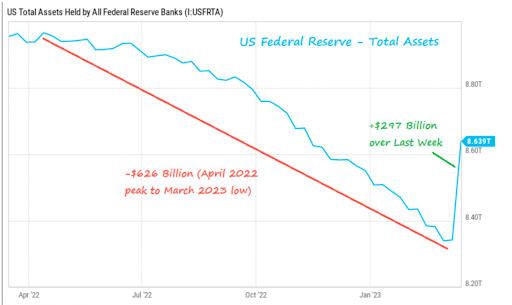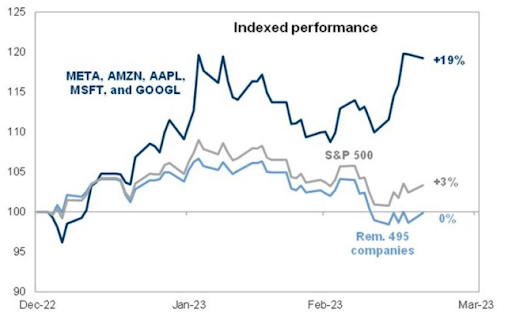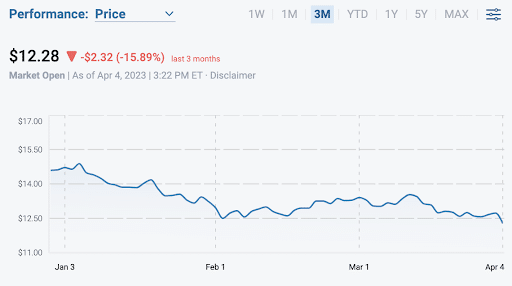How To Hedge Against A 10% Correction
Share

Most everyone came into 2023 expecting a rough first half on expectations continued rate hikes would lead to economic contraction, if not a full blown recession.
Instead, January was one of the best months on record as economic data remained robust while inflation began to ebb, lending credence to the notion of a ‘no landing’ scenario.
Following the recent mini-banking crisis, expectations are now for an even more severe contraction as both demand for loans, which the yields or the cost to borrow are significantly higher, and the desire to lend due to risk factors, have fallen off a cliff.
Despite all the bearish economic indicators, we have seen a sharp rebound in the markets since the run on the bank that took place mid-March. In the three weeks since SVB’s historic collapse, the Nasdaq 100 (QQQ) has rallied over 9.2% and the SPDR 500 (SPY) is up 4.1%. The first three months of 2023 delivered the best quarterly performance since Q2 of 2020.
Given the broader context, I don’t think very many people expected this to be the case. However, there of course is always the old saying to remember, what goes up, must come down.
However euphoric this kind of bullishness feels in the face of a recession, there is still the question of whether or not this rally is on shaky ground. Providing yourself with some downside protection when the market is roaring might sound counterintuitive, but that’s just when you should think about it. Be fearful when others are greedy, as they say…
So, what steps can we take to hedge or minimize the damage of a market sell-off.
Morgan Stanley’s Michael Wilson — among the most prominent bearish voices on US equities — warns the rally in tech stocks that’s exceeded 20% isn’t sustainable and that the sector will return to new lows.
First, I would point out that the Fed’s response to the bank failures has led to a huge injection of liquidity. In the past two weeks, they have reversed half of the $626 billion drained from its balance sheet over the prior year. Meaning, we have gone from Quantitative Tightening back to Quantitative Easing.
An issue giving me concern is the fact Apple (AAPL) and Microsoft (MSFT) account for a whopping 14.6% and 5.1% respectively of the QQQ and SPY market caps. Those are all-time records for two names eclipsing IBM (IBM) and Exxon (XOM) from the late 1980s.
Another cause for concern, in terms of the Nasdaq and S&P 500, only a handful of stocks make a large amount of those indexes. A total of seven companies make up for 51.1% of the Nasdaq and 24.2% of the S&P 500. These are companies like – AAPL, MSFT, AMZN, GOOGL, TSLA, NVDA, META.
If one domino falls, not only does the tech sector fall, but so does the overall market as investors flee these names and spook the rest of the market in the process.
Take away those names and you take away the gains.
Wilson said this rotation is taking place partly because tech is being viewed as a traditional defensive sector, though he disagrees with that thesis and sees Utilities, Consumer Staples, and Health Care as having the better risk-reward profile.
“Tech is actually more pro-cyclical and bottoms coincidently with the broader market in bear markets,” the strategist — who ranked No. 1 in last year’s Institutional Investor survey after he correctly predicted the selloff in stocks.
JPMorgan Chase strategists like Mislav Matejka also said tech “might not be a great place to position structurally anymore.”
The sector will stop strongly outperforming due to earnings risks, unattractive valuations, and very high price relatives in the long-term context, leaving many strategists neutral.
However, many investors who may own those large- to mega-cap names through retirement accounts or broad based ETFs might be reluctant to sell as they not only have a bullish longer term view, but also don’t want to incur tax consequences of closing positions with large profits.
One way to hedge would be to establish a small position in the ProShares Short QQQ ETF (PSQ). PSQ provides inverse exposure to a modified market-cap-weighted index of 100 of the largest non-financial firms listed on Nasdaq.
In this way, we use the heavy concentration of these large-cap tech names to our advantage. It will only take a modest position in PSQ to provide a broad hedge for portfolios that resemble or track the major indices such as SPY and QQQ.
As an inverse ETF, it is structured to move opposite of the QQQ; meaning if QQQ goes up 1%, we can expect PSQ to go down by 1%. On the other hand, if the Nasdaq or QQQ declines by 10% over the next few months the PSQ should increase 10% in value over that time period.
As the Nasdaq and large-cap tech stocks benefit from the fall-out from the financial sector chaos the gains may not be built on solid ground and could be short-lived.
Check out my weekly commentary when you sign up for All Star Funds VIP content. Here you’ll not only have access to all my weekly newsletters, but you’ll also have VIP access to interviews with the industry’s top experts. Join today!





